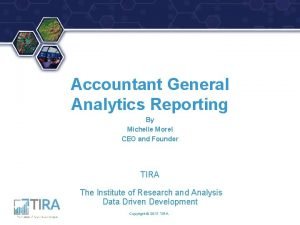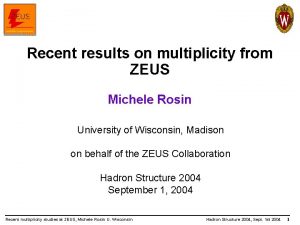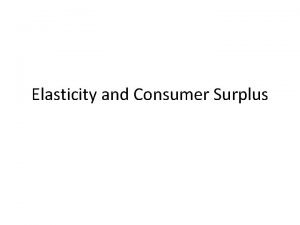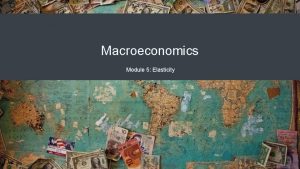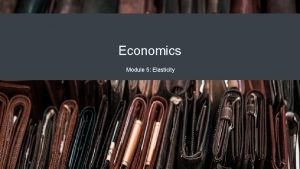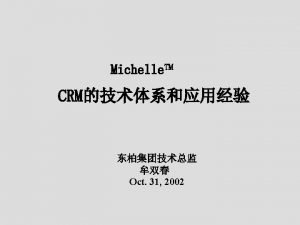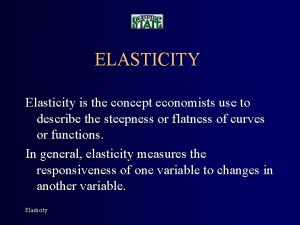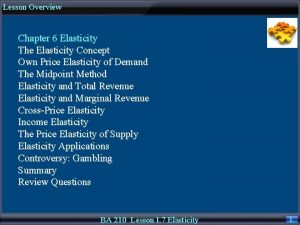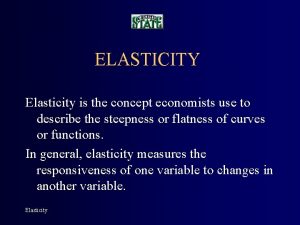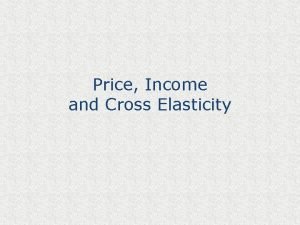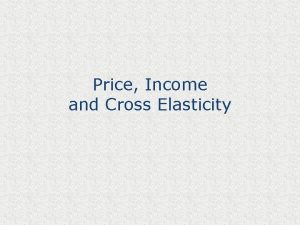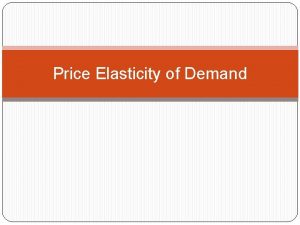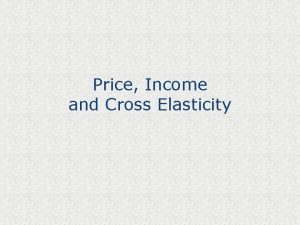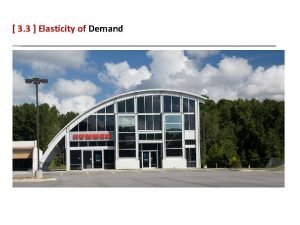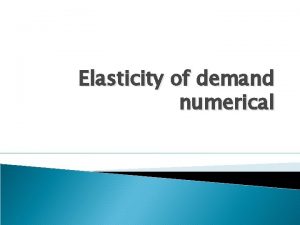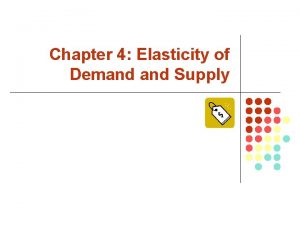ELASTICITY Dr Michelle Commosioung Elasticity the concept The


















































- Slides: 50

ELASTICITY Dr. Michelle Commosioung

Elasticity – the concept • The responsiveness of one variable to changes in another • When price rises, what happens to demand? • Demand falls • BUT! • How much does demand fall?

Elasticity – the concept • If price rises by 10% - what happens to demand? • We know demand will fall • By more than 10%? • By less than 10%? • Elasticity measures the extent to which demand will change

Importance of Elasticity • Relationship between changes in price and total revenue • Importance in determining what goods to tax (tax revenue) • Importance in analysing time lags in production • Influences the behaviour of a firm

Determinants of Elasticity • Number and closeness of substitutes – the greater the number of substitutes, the more elastic • The proportion of income taken up by the product – the smaller the proportion the more inelastic • Time period – the longer the time under consideration the more elastic a good is likely to be • Luxury or Necessity - for example, addictive drugs

Elasticity • • • 4 basic types used: Price elasticity of demand Price elasticity of supply Income elasticity of demand Cross price elasticity

P Infinitely elastic demand a b Q 1 Q 2 P 1 O D Q

P Totally inelastic demand D P 2 b P 1 a O Q 1 Q

P 20 Unit elastic demand a b 8 O This demand curve is known as a rectangular hyperbola. Notice that TR is the same at points a and b (800) D 40 100 Q

Elasticity Price (J$) The demand curve can be a range of shapes each of which is associated with a different relationship between price and the quantity demanded. Quantity Demanded

Elasticity • Price Elasticity of Demand – The responsiveness of demand to changes in price The Formula: Ped = % Change in Quantity Demanded ______________ % Change in Price

– Where % change in demand is greater than % change in price – elastic – Where % change in demand is less than % change in price - inelastic

CALCULATING ELASTICITIES • CALCULATING PERCENTAGE CHANGES • To calculate percentage change in quantity demanded using the initial value as the base, the following formula is used:

CALCULATING ELASTICITIES • We can calculate the percentage change in price in a similar way. Once again, let us use the initial value of P—that is, P 1—as the base for calculating the percentage. By using P 1 as the base, the formula for calculating the percentage of change in P is simply:

CALCULATING ELASTICITIES • ELASTICITY IS A RATIO OF PERCENTAGES • Once all the changes in quantity demanded and price have been converted into percentages, calculating elasticity is a matter of simple division. Recall the formal definition of elasticity:

Product Price Elasticity of demand 0. 21 0. 22 Food Medical Services Housing Rental Owner Occupied Electricity Cars Beer Wine Cigarettes Transatlantic air travel Imports 0. 18 1. 20 1. 14 1. 20 0. 26 0. 88 0. 35 1. 30 0. 58 Source: W. Nicholson, Microeconomic Theory: Basic Principles and extensions, 7 th edition, p. 230




Importance of Price Elasticity of Demand to Business Decision-Making Price Total revenue is of price x The importance elasticity quantity sold. In this is the information it example, TR = $5 x 100, 000 provides on the effect on = $500, 000. total revenue of changes in price. This value is represented by the grey shaded rectangle. $5 Total Revenue D 100 Quantity Demanded (000 s)

Elasticity Price If the firm decides to decrease price to (say) $3, the degree of price elasticity of the demand curve would determine the extent of the increase in demand the change therefore in total revenue. $5 $3 Total Revenue D 100 140 Quantity Demanded (000 s)

Elasticity Price ($) Producer decides to lower price to attract sales % Δ Price = 50% 10 % Δ Quantity Demanded = 20% Ped = 0. 4 (Inelastic) Total Revenue would fall 5 Not a good move! D 5 6 Quantity Demanded

Elasticity Price ($) 10 Producer decides to reduce price to increase sales % Δ in Price = 30% % Δ in Demand = 300% Ped = 10 (Elastic) Total Revenue rises Good Move! 7 D 5 Quantity Demanded 20

Elasticity If demand is price elastic: • Increasing price would reduce TR • Reducing price would increase TR If demand is price inelastic: • Increasing price would increase TR • Reducing price would reduce TR

Elasticity • Income Elasticity of Demand: – Measures the responsiveness of demand to changes in income

EM= % Qd = 60 % = 1. 8 % M 33. 3% EM E>1 M normal good E<1 M inferior good

Income elasticity of demand is an important concept to firms considering the future size of the market for their product (e. g. if national income rises or if the economy moves into recession)

Product Income Elasticity of demand 0. 28 0. 22 Food Medical Services Housing Rental Owner Occupied Electricity Cars Beer Wine Cigarettes Transatlantic air travel Imports 1. 00 1. 20 0. 61 3. 00 0. 38 0. 97 0. 50 1. 40 2. 73 Source: W. Nicholson, Microeconomic Theory: Basic Principles and extensions, 7 th edition, p. 230

Elasticity • Cross-price (or simply Cross Elasticity): Measures the responsiveness of demand of one good to changes in the price of a related good – either a substitute or a complement %_________ Δ Qd of good t Xed = % Δ Price of good y

In other words, cross-price elasticity enables us to predict how much demand for one product will shift when the price of a second product changes (e. g. the cross price elasticity of demand for Coca-Cola to the price of Pepsi)

Elasticity • Goods which are complements: – Cross Elasticity will have negative sign (inverse relationship between the two) • Goods which are substitutes: – Cross Elasticity will have a positive sign (positive relationship between the two)

Elasticity • Price Elasticity of Supply: – Measures the responsiveness of supply to changes in price – If Pes is inelastic - it will be difficult for suppliers to react swiftly to changes in price – If Pes is elastic – supply can react quickly to changes in price %Δ Quantity Supplied __________ Pes = % Δ Price

Price of a chocolate bar 70 P(in cents) 0 S 60 G 50 66/% 40 A 30 20 10 0 0 40 80 120 160 200 240 100% Quantity of chocolate s bars supplied Q 0 (in millions of bars per day)

s s % Q 0 100% E P 0 15. % P 0 66. 6% Price Elasticity of Supply is Elastic

Supply is Elastic if firms have: • Plenty of spare capacity • Can readily get extra supplies of raw materials • Can switch away from producing one good to the next

Price Elasticity of Supply is affected by: • The amount that costs rise as output rises Hence, the cheaper it is to produce additional output, the more firms will be encouraged to produce for a given price rise, that is, Supply will become more Elastic. • Time period Both consumers and producers take time to respond to a change in price. The longer the time period, the greater the response, that is, the greater the elasticity of supply or demand.


The Time Dimension of Market Adjustment • Short-run and long-run price adjustment – short and long-run demand supply curves

P Supply in different time periods P 1 a D 1 O Q 1 Q

P Supply in different time periods P 1 a D 2 D 1 O Q 1 Q

P P 2 Supply in different time periods Si b P 1 a D 2 D 1 O Q 1 Q

P P 2 Supply in different time periods Si SS b c P 3 P 1 a D 2 D 1 O Q 1 Q 3 Q

P P 2 Supply in different time periods Si SS b c P 3 P 4 SL d P 1 a D 2 D 1 O Q 1 Q 3 Q 4 Q

Response of demand to an increase in supply P S 1 a P 1 O Q 1 Q

Response of demand to an increase in supply P S 1 S 2 a P 1 O Q 1 Q

Response of demand to an increase in supply P S 1 S 2 a P 1 b P 2 D short-run O Q 1 Q 2 Q

Response of demand to an increase in supply P S 1 S 2 a P 1 P 3 P 2 c Demand is more elastic in the long run. b D long-run D short-run O Q 1 Q 2 Q 3 Q

PRICE ELASTICITY OF DEMAND • A good way to remember the difference between the two “perfect” elasticities is:

–Applications to business • importance of perceptions of the product • repositioning a product • effects of changes in competitors' pricing strategy • strategies to make a product less cross-price elastic

Elasticity – Mind Map
 Actual vs ideal
Actual vs ideal Contoh selling concept
Contoh selling concept điện thế nghỉ
điện thế nghỉ Michelle heim
Michelle heim Superhero social skills
Superhero social skills Michelle ballin
Michelle ballin Chúa yêu trần thế
Chúa yêu trần thế Michelle taylor xxx
Michelle taylor xxx Michelle buchanan ornl
Michelle buchanan ornl Michelle brailsford
Michelle brailsford Dr michelle butler
Dr michelle butler Sinus rhythm
Sinus rhythm Blanca orozco
Blanca orozco Phản ứng thế ankan
Phản ứng thế ankan Colloquial language
Colloquial language Mental health policy, plans and programmes michelle funk
Mental health policy, plans and programmes michelle funk Khi nào hổ mẹ dạy hổ con săn mồi
Khi nào hổ mẹ dạy hổ con săn mồi Trời xanh đây là của chúng ta thể thơ
Trời xanh đây là của chúng ta thể thơ Sbliftoff
Sbliftoff Số.nguyên tố
Số.nguyên tố Michelle petri md
Michelle petri md Michelle kuttel
Michelle kuttel Michelle wilkins dr phil
Michelle wilkins dr phil Michelle warkentin
Michelle warkentin Michelle morel
Michelle morel Michelle bommarito
Michelle bommarito Michelle rotermann
Michelle rotermann Natalie amin
Natalie amin Michelle cheatham
Michelle cheatham Michelle paape
Michelle paape Hình ảnh bộ gõ cơ thể búng tay
Hình ảnh bộ gõ cơ thể búng tay Quá trình desamine hóa có thể tạo ra
Quá trình desamine hóa có thể tạo ra Từ ngữ thể hiện lòng nhân hậu
Từ ngữ thể hiện lòng nhân hậu Michelle turpin
Michelle turpin Federica esposito trans
Federica esposito trans Michelle verrochi
Michelle verrochi Michelle chitambar
Michelle chitambar Ao summer internship
Ao summer internship Tia chieu sa te
Tia chieu sa te Dr michelle davenport
Dr michelle davenport Aiman putra
Aiman putra Giọng cùng tên là
Giọng cùng tên là Michelle harkins
Michelle harkins Michelle miranda principal
Michelle miranda principal What happened to michelle from the documentary playground
What happened to michelle from the documentary playground Biện pháp chống mỏi cơ
Biện pháp chống mỏi cơ Michelle colodzin
Michelle colodzin Zev sunleaf
Zev sunleaf Kristen gianaris
Kristen gianaris Tư thế ngồi viết
Tư thế ngồi viết Eventbreit
Eventbreit
























